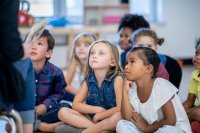4 Tips for Using Stories in the Early Grades
A look at what the research tells us about sharing stories with kids in preschool and kindergarten.
As in higher grades, stories are often an important part of early learning environments. Whether shared by teachers, children, family members, or authors, stories can help children process and understand their daily experiences, explore a new topic, or express their responses to or emotions about a situation.
While different types of media tell stories, books—both print and digital—can be a starting point when figuring out how to best integrate stories in your classroom. In my work, I’ve noticed that teachers often focus on both integrating existing stories and creating and integrating new stories.
Both of these approaches offer opportunities to support children’s learning and to enhance their relationships with their peers, educators, and families. Here are some research-based practices that can guide story integration and creation when working with young children.
4 Tips for Working With Stories in Early Grades
1. Have a diverse selection of stories in your room. When integrating books, whether print or digital, it’s important to have a balance between books that reflect the children’s culture, language, background, identities, and abilities, and books that expose them to different ways of living, being, and doing.
Selecting books that are culturally relevant can positively impact children’s motivation and engagement in literacy activities, which in turn enhances their emergent literacy. Additionally, having a variety of books that offer diverse representation of groups and identities can show children different perspectives and ways of life.
Having multiple books that represent a culture is important since there are variations within cultural groups and one book cannot authentically and accurately represent all the dynamics of a culture.
2. Build stories from children’s experiences. Even though more diverse print and digital books are being published, there may not be stories that may reflect your children’s culture, language, background etc. For this reason—among others—creating stories with children that build on their experiences can be helpful.
Using verbal prompts to initiate or extend a story can help guide children through the process and show them how to express their ideas. You can use photos taken by the children to generate stories or recount events, either verbally or by doing some form of writing or drawing.
3. Use different storytelling and creation tools to support the diversity of students. Listening to and reading books may positively influence young children’s desire to retell or recreate existing stories or to construct ones of their own. In addition to building on their motivation, providing opportunities for children to construct stories can also support their narrative learning.
When you have young children retell, recreate, or construct stories, it’s important to recognize the variation they may have with communicating and expressing their ideas. Taking this into account by having an assortment of tools gives students options for finding tools that will work for them.
For instance, you can have them use props like fabric, small blocks, animal figures, or paper to initiate ideas for new stories or to modify existing ones. With multimedia tools like VoiceThread, ScratchJr, and apps for book creation, children can capture their stories using a combination of mediums—audio, visual, written, etc. Depending on the tool and the goals of the project or activity, the educator’s involvement in the creation process will vary.
4. Include families in storytelling and creation. During early childhood, families are a valuable part of the learning community. Including them in activities related to stories can help build the home-school connection, make stories relevant to students, and demonstrate the collaborative nature of the early learning community.
Families can read books from the classroom library at home and reflect together on the books’ topics in a family reading journal. Families can also tell stories to the classroom community that are reflective of their experiences and culture, by either coming into the classroom or making an audio or video recording of a story for the teacher to play during class time. In addition to reading to their kids, families can collaborate with students or with each other to create their own stories.
Finding a balance between integrating existing stories and creating ones that reflect children’s interests and experiences takes time. Each teacher will have their own approach, have access to different tools, and work with a different group of children and families.
Keeping an open mind about exploring tools and learning from research can help you in finding storytelling and story creation strategies that are authentic to you and your practice.
